Who was Josephine Baker's Father?
The facts around Josephine's birth are not agreed upon by biographers.
What we do know, is that her mother, Carrie, was adopted in 1886 by Richard and Elvira McDonald of Little Rock, Arkansas. The couple were former slaves that are considered, today, to be of African-American and Native American decent. Being Native American may seem strange to some, but during the Civil War and afterwards. Many Native American communities permitted escaped slaves to become members of their tribe.
Another example of that practice relates to a favorite actor on mine. He's one time L.A. Rams player Woody Strode. Woody Strode was in John Ford's "Sergeant Rutledge" and "The Man Who Shot Liberty Valence". His parents did not consider themselves "Black", but Native American. His father was Creek and Blackfoot. While Strode's mother was Cherokee. The actor basically considered himself Native American.


My article on the Woody Strode's career may be read at:
http://www.bewaretheblog.com/2015/03/woody-strode-and-michael-pate-one.html
According to many accounts Carrie McDonald arrived in St. Louis, Missouri sometime in 1904. We do not know the why of this move, or if her adopted parents were still living in Little Rock. Her daughter was born June 3, 1906 and named Freda Josephine McDonald.

The question of who the future Josephine Baker's father was is part of a debate on her life. According to the "Official Josephine Baker Website" he was African-American:
However, Josephine Baker's foster son Jean-Claude Baker in his 1993 biography "Josephine Baker: The Hungry Heart" wrote:
The Facebook page: "Black Then: Discovering Our History", dated November 3, 2017, states:
https://www.ancestry.com/genealogy/records/eddie-carson_49213127
However, the father of the other children would seem to be clarified and fit the accepted story on the website "Preceden":
Why the comment "The First kid of eddie carson who was a drummer, and Carrie Mcdonald"? Are they implying there were others children by the couple, or was this just a weird typo? Whatever, others thought the same.
The website "Encyclopedia.com" uses that exact wording about Josephine being the first child of Eddie Carson and Carrie McDonald.
http://www.encyclopedia.com/people/literature-and-arts/music-popular-and-jazz-biographies/josephine-baker
That might support "Ancestry.com", or show that on line biography's are not being verified, because if Eddie actually left after a year. How could he have fathered all four of Carrie McDonald's children?
Still another site by a fellow blogger called: "Bree's Blog" further adds confusion to Freda's father by clearly stating"
Where did that come from?
As to those other children. We know as fact that Carrie married a man named Arthur Martin and some sites state the two girls Margaret and Willie Mae and the boy Richard were his.
However, Ancestry.com indicates he had no children when married to Carrie.
https://www.ancestry.com/genealogy/records/arthur-martin_92893844
Ancestry is supposedly researching their posted information from public sources. So are they correct, or is everyone else wrong? The 1920 Census states there were three children living in the home with Carrie and Arthur. I could not locate their ages and dates of birth. That would completely clear the controversy..
Returning to Carrie and Eddie I found another discrepancy in their story.
Some sources state they had a song and dance vaudeville act, when they could find work, and by the time Freda was one year old. Her parents were bringing the little girl on the stage at the act's conclusion..The date would have to be past June 3,1907 to be true. Which adds to the confusion as supposedly some sources state Eddie walked out on Carrie and Freda in 1906 right after her birth.
It is also probable that some of their vaudeville gigs were through the "Chitlin Circuit". Which was a means of booking Black performers into Black Clubs across the South and North East. White performers worked their bookings through the "Theater Owners Booking Association (TOBA)". Referred in the African-American Community as "Tough On Black Actors".
We know that the family lived at 212 Targee (aka: Johnson) Street, at the time at least, when Carrie was living with Eddie. There were three movie houses that doubled for vaudeville venues in the neighborhood. They were the "Jazzland", "Booker T. Washington" and "The Comet". It's also probable these were also the only venues Josephine's parents worked. Although there were many others in the White neighborhoods.
The family lived in the "Mill Creek Neighborhood" of the city. In an ad for his his book "Mill Creek Valley, a Soul of St,. Louis". Author Ron Fagerstrom describes the area's death to urban renewal in 1959.
By the age of 8 Freda McDonald was working as a domestic in people's homes. By the age of 12 she had dropped out of Lincoln Avenue school. Some sites say she was living on the streets, living in cardboard boxes and scavaging for food, if so, why had she left her mother and step father? Again I could not find any information about the family at this time.
One year later in 1919 13 year old Freda Josephine McDonald married Willie Wells sometimes mentioned as a train "Pullman Car Conductor". At the time the young girl/women was working as a waitress at "The Old Chauffer's Club" located at 3133 Pine Street. The fact she was working would seem to imply the story of her living on the streets might be incorrect in some respects.The marriage lasted one year and ended in a 1920 divorce.
By this time there was a definite riff between Freda and her mother over the young women's street dancing. According to sources Carrie did not want her daughter becoming an entertainer. Could this have started earlier and the girl had left her home as a preteen for the streets?
In 1921, at the age of 15, several major events occurred in Freda's life. The year started with her continuing to work as part of two street performance groups the "Jones Family Band" and "The Dixie Steppers". These groups did play at the Booker T. Washington theater. That dancing led to Freda being recruited by the "St. Louis Chorus" vaudeville troop. She also met and married William Baker. What plans they might have been making for their life was interrupted by another event that demonstrated a overwhelming "Drive" in the young Freda Baker.

The "St. Louis Chorus" vaudeville troop was booked in a major Harlem, New York venue. Freda apparently just up and left William and went with them. He did not accompany his wife at the time and I could not locate any information, if William had ever gone to New York to be with her.
"Harlem" in the 1920's was experiencing what became known as the "Harlem Renaissance". The actual period ran from 1918 through the mid 1930's. Both fashion and music changed greatly and helped join the "Poor Negro", the life Josephine was in the process of leaving, with the "Elite Negro". A pride developed during this period creating what was considered in the community as the "New Negro" and through music it crossed the race barrier. A new kind of Jazz by musicians such as Trumpeter John Birks "Dizzy" Gillespie and pianist Thomas Wright "Fats" Waller had been created. The "Roaring Twenties" were in full swing and "Negro" musicians were appearing in White "Speak Easy's".


This was the world the now Josephine Baker, she kept William's last name throughout her other two marriages, arrived with the "St. Louis Chorus" in either late 1921, or early 1922.
Shortly after this arrival that "Drive" I mentioned kicked in once more. As Josephine attempted to get a job as a performer in the Broadway musical "Shuffle Along". Described on the website "Blondie Cuts A Rug":
http://blondiecutsarug.blogspot.com/2013/05/shuffle-along.html

Below is a photo of the chorus line from "Shuffle Along". Josephine Baker is the sixth lady from the right.

In 1924 Josephine was part of the chorus in "The Chocolate Dandies". The show opened on September 1, 1924 and ran through November 22, 1924 for 96 performances. In what was a set up for the audience. Josephine was the last girl in the chorus line and acted as if she couldn't remember the dance number, but when the encore started. Baker not only knew the dance, but went into extremely complex dancing moves for that year.
![baker4[1]](https://cerebellumtellum.files.wordpress.com/2014/01/baker41.jpg?w=328&h=429)
The facts around Josephine's birth are not agreed upon by biographers.
What we do know, is that her mother, Carrie, was adopted in 1886 by Richard and Elvira McDonald of Little Rock, Arkansas. The couple were former slaves that are considered, today, to be of African-American and Native American decent. Being Native American may seem strange to some, but during the Civil War and afterwards. Many Native American communities permitted escaped slaves to become members of their tribe.
Another example of that practice relates to a favorite actor on mine. He's one time L.A. Rams player Woody Strode. Woody Strode was in John Ford's "Sergeant Rutledge" and "The Man Who Shot Liberty Valence". His parents did not consider themselves "Black", but Native American. His father was Creek and Blackfoot. While Strode's mother was Cherokee. The actor basically considered himself Native American.

My article on the Woody Strode's career may be read at:
http://www.bewaretheblog.com/2015/03/woody-strode-and-michael-pate-one.html
According to many accounts Carrie McDonald arrived in St. Louis, Missouri sometime in 1904. We do not know the why of this move, or if her adopted parents were still living in Little Rock. Her daughter was born June 3, 1906 and named Freda Josephine McDonald.

The question of who the future Josephine Baker's father was is part of a debate on her life. According to the "Official Josephine Baker Website" he was African-American:
and vaudeville drummer Eddie Carson. Eddie abandoned them shortly afterward, and Carrie married a kind but perpetually unemployed man named Arthur Martin. Their family eventually grew to include a son and two more daughters.https://www.cmgww.com/stars/baker/about/biography/
However, Josephine Baker's foster son Jean-Claude Baker in his 1993 biography "Josephine Baker: The Hungry Heart" wrote:
The records of the city of St. Louis tell an almost unbelievable story. They show that (Josephine Baker's mother) Carrie McDonald ... was admitted to the (exclusively white) Female Hospital on May 3, 1906, diagnosed as pregnant. She was discharged on June 17, her baby, Freda J. McDonald having been born two weeks earlier. Why six weeks in the hospital? Especially for a black woman (of that time) who would customarily have had her baby at home with the help of a midwife? Obviously, there had been complications with the pregnancy, but Carrie's chart reveals no details. The father was identified (on the birth certificate) simply as "Edw" ... I think Josephine's father was white—so did Josephine, so did her family ... people in St. Louis say that (Baker's mother) had worked for a German family (around the time she became pregnant). He's the one who must have got her into that hospital and paid to keep her there all those weeks. Also, her baby's birth was registered by the head of the hospital at a time when most black births were not. I have unraveled many mysteries associated with Josephine Baker, but the most painful mystery of her life, the mystery of her father's identity, I could not solve. The secret died with Carrie, who refused to the end to talk about it. She let people think Eddie Carson was the father, and Carson played along, (but) Josephine knew betterAlthough Jean-Claude took the above position. I went on several websites and other sources. The accepted story of Josephine's birth is that Eddie Carson was her father. To illustrate here are two more quotes.
The Facebook page: "Black Then: Discovering Our History", dated November 3, 2017, states:
Josephine Baker was born on June 3, 1906 in Saint Louis, Missouri. Her parents, Eddie Carson and Carrie McDonald, had a vaudeville act. The family was impoverished, and Baker never had enough to eat or clothes to wear.Besides Jean-Claude's theory her father wasn't African American, but a White unknown man. The website "Ancestry.com" ads more confusion to her history. The site indicates that Carrie McDonald and Eddie Carson had four children. They were Margaret Carson, Willie Mae Carson, Richard Carson and Josephine Freda Carson. Which would run counter to most accounts which stated Eddie left a year after Freda's birth.
https://www.ancestry.com/genealogy/records/eddie-carson_49213127
However, the father of the other children would seem to be clarified and fit the accepted story on the website "Preceden":
Born in st. Louis, Missorui. The First kid of eddie carson who was a drummer, and Carrie Mcdonald. Before Josephine was a year old her dad left. Her mom had 3 other kids with another man.https://www.preceden.com/timelines/49095-joesphine-baker
Why the comment "The First kid of eddie carson who was a drummer, and Carrie Mcdonald"? Are they implying there were others children by the couple, or was this just a weird typo? Whatever, others thought the same.
The website "Encyclopedia.com" uses that exact wording about Josephine being the first child of Eddie Carson and Carrie McDonald.
http://www.encyclopedia.com/people/literature-and-arts/music-popular-and-jazz-biographies/josephine-baker
That might support "Ancestry.com", or show that on line biography's are not being verified, because if Eddie actually left after a year. How could he have fathered all four of Carrie McDonald's children?
Still another site by a fellow blogger called: "Bree's Blog" further adds confusion to Freda's father by clearly stating"
Her farther was a Spaniard, name unknown.http://briannabarkersblog.blogspot.com/2013/04/josephine-baker.html
Where did that come from?
As to those other children. We know as fact that Carrie married a man named Arthur Martin and some sites state the two girls Margaret and Willie Mae and the boy Richard were his.
However, Ancestry.com indicates he had no children when married to Carrie.
https://www.ancestry.com/genealogy/records/arthur-martin_92893844
Ancestry is supposedly researching their posted information from public sources. So are they correct, or is everyone else wrong? The 1920 Census states there were three children living in the home with Carrie and Arthur. I could not locate their ages and dates of birth. That would completely clear the controversy..
Returning to Carrie and Eddie I found another discrepancy in their story.
Some sources state they had a song and dance vaudeville act, when they could find work, and by the time Freda was one year old. Her parents were bringing the little girl on the stage at the act's conclusion..The date would have to be past June 3,1907 to be true. Which adds to the confusion as supposedly some sources state Eddie walked out on Carrie and Freda in 1906 right after her birth.
It is also probable that some of their vaudeville gigs were through the "Chitlin Circuit". Which was a means of booking Black performers into Black Clubs across the South and North East. White performers worked their bookings through the "Theater Owners Booking Association (TOBA)". Referred in the African-American Community as "Tough On Black Actors".
We know that the family lived at 212 Targee (aka: Johnson) Street, at the time at least, when Carrie was living with Eddie. There were three movie houses that doubled for vaudeville venues in the neighborhood. They were the "Jazzland", "Booker T. Washington" and "The Comet". It's also probable these were also the only venues Josephine's parents worked. Although there were many others in the White neighborhoods.
The family lived in the "Mill Creek Neighborhood" of the city. In an ad for his his book "Mill Creek Valley, a Soul of St,. Louis". Author Ron Fagerstrom describes the area's death to urban renewal in 1959.
This entire neighborhood, home to 20,000 persons (95% black), over 800 businesses, church's and other institutions, and center of St. Louis’s black community, was erased forever from our civic life.The Road to Fame
By the age of 8 Freda McDonald was working as a domestic in people's homes. By the age of 12 she had dropped out of Lincoln Avenue school. Some sites say she was living on the streets, living in cardboard boxes and scavaging for food, if so, why had she left her mother and step father? Again I could not find any information about the family at this time.
One year later in 1919 13 year old Freda Josephine McDonald married Willie Wells sometimes mentioned as a train "Pullman Car Conductor". At the time the young girl/women was working as a waitress at "The Old Chauffer's Club" located at 3133 Pine Street. The fact she was working would seem to imply the story of her living on the streets might be incorrect in some respects.The marriage lasted one year and ended in a 1920 divorce.
By this time there was a definite riff between Freda and her mother over the young women's street dancing. According to sources Carrie did not want her daughter becoming an entertainer. Could this have started earlier and the girl had left her home as a preteen for the streets?
In 1921, at the age of 15, several major events occurred in Freda's life. The year started with her continuing to work as part of two street performance groups the "Jones Family Band" and "The Dixie Steppers". These groups did play at the Booker T. Washington theater. That dancing led to Freda being recruited by the "St. Louis Chorus" vaudeville troop. She also met and married William Baker. What plans they might have been making for their life was interrupted by another event that demonstrated a overwhelming "Drive" in the young Freda Baker.

The "St. Louis Chorus" vaudeville troop was booked in a major Harlem, New York venue. Freda apparently just up and left William and went with them. He did not accompany his wife at the time and I could not locate any information, if William had ever gone to New York to be with her.
"Harlem" in the 1920's was experiencing what became known as the "Harlem Renaissance". The actual period ran from 1918 through the mid 1930's. Both fashion and music changed greatly and helped join the "Poor Negro", the life Josephine was in the process of leaving, with the "Elite Negro". A pride developed during this period creating what was considered in the community as the "New Negro" and through music it crossed the race barrier. A new kind of Jazz by musicians such as Trumpeter John Birks "Dizzy" Gillespie and pianist Thomas Wright "Fats" Waller had been created. The "Roaring Twenties" were in full swing and "Negro" musicians were appearing in White "Speak Easy's".


This was the world the now Josephine Baker, she kept William's last name throughout her other two marriages, arrived with the "St. Louis Chorus" in either late 1921, or early 1922.
Shortly after this arrival that "Drive" I mentioned kicked in once more. As Josephine attempted to get a job as a performer in the Broadway musical "Shuffle Along". Described on the website "Blondie Cuts A Rug":
On May 23, 1921 Shuffle Along opened at Daly's 63rd Street Theater and ran for an unprecedented 504 performances. It was the first musical written, performed, produced and directed by African-Americans after a decade of decline of black performers in theater.The producers would not hire a still 15 year old "Girl" for the Broadway cast, but placed her with the Boston Touring Company. She wasn't long touring, because by the age of 16 Josephine Baker was on Broadway in "Shuffle Along". The following link takes my reader to the website "Blondie Cuts A Rug" and the article on the musical.
http://blondiecutsarug.blogspot.com/2013/05/shuffle-along.html

Below is a photo of the chorus line from "Shuffle Along". Josephine Baker is the sixth lady from the right.

In 1924 Josephine was part of the chorus in "The Chocolate Dandies". The show opened on September 1, 1924 and ran through November 22, 1924 for 96 performances. In what was a set up for the audience. Josephine was the last girl in the chorus line and acted as if she couldn't remember the dance number, but when the encore started. Baker not only knew the dance, but went into extremely complex dancing moves for that year.
![baker4[1]](https://cerebellumtellum.files.wordpress.com/2014/01/baker41.jpg?w=328&h=429)
Above Josephine Baker, as shown in the program for "The Chocolate Dandies". She is billed as both "That Comedy Chorus Girl" and "A Deserted Female". At the time of this production, according to her step son Jean-Claude, his step mother was:
The highest paid chorus girl in vaudeville.An yes, she is wearing blackface make-up in this publicity photo for the show. The wearing of blackface, by Black performers, for White audiences, started with the inventor of tap dancing, William Henry Lane, known as "Master Juba", in the mid-1840's.
The practice used by White performers, such as Al Jolson in the, so-called, first talking motion picture, 1927's, "The Jazz Singer", was criticized by such prominent men as Fredrick Douglas. Yet, Negro Minstrel shows continued to use blackface, themselves, for white audiences. Which did not help to prevent racial stereotyping.
Appearing in "The Chocolate Dandies" had not been the first time Josephine Baker had worn blackface. According to some sources Freda wearing blackafce as a street dancer was one of the complaints her mother, Carrie, had with the girl over becoming an entertainer.
Appearing in "The Chocolate Dandies" had not been the first time Josephine Baker had worn blackface. According to some sources Freda wearing blackafce as a street dancer was one of the complaints her mother, Carrie, had with the girl over becoming an entertainer.
The following quote is alleged to have been by Josephine Baker, but is not confirmed as actual. It comes from an article on the website "Owlcation":
One day I realized I was living in a country where I was afraid to be black. It was only a country for white people. Not black. So I left. I had been suffocating in the United States.... A lot of us left, not because we wanted to leave, but because we couldn't stand it anymore.... I felt liberated in Paris.https://owlcation.com/humanities/When-Frida-Kahlo-Set-Her-Eyes-on-Josephine-Baker
After the run of "The Chocolate Dandies" Josephine left the United States for France.
France Before the Second World War
On October 2, 1925 Josephine Baker opened in "La Reveue Negre" at the "Theatre de Champs-Elysees".


La Revue nègre est un spectacle musical créé en 1925 à Paris. Par son succès et la personnalité de Josephine Baker qui en est l'étoile montante, elle permet entre autres une diffusion plus large de la musique de jazz et de la culture noire en Europe
The negro Review is a musical created in 1925 in Paris . With its success and the personality of Josephine Baker who is the rising star, it allows among other things a wider diffusion of jazz music and black culture in Europe.

Above 19 year old Josephine Baker and Joe Alex in the opening night performance of "La Revue Negre". Baker toured with the revenue throughout Europe and was known for appearing almost totally nude on stage doing her dance routines. .
At some point just after arriving in France. Josephine met a fake Sicilian "Count" named Giuseppe Peplito Abatino. He actually had been a working class stone mason. Abatino convinced the young women to let him become her manager. Fake "Count", or not. He was a strong guiding influence that helped bring focus to Josephine Baker's career.
There are some websites that move the year the two met to 7 years after her arrival to 1931. While others state that the two, became lovers because she was still married to William Baker. That would make more sense as she did not divorce William Baker until 1925 after coming to France that same year. There is no evidence that William and Josephine where ever together after she left him for Harlem.
One fact does remain clear. One year after arriving in France Josephine Baker broke her contract with "La Revue Negre" and took up an offer in 1926 to appear in Paris in the "Folies Bergere", if Abatino was involved in that decision. That would establish the year he became Josephine's manager and the start of a focused career.


There was a new form of architecture that was seen in 1925 France at the "Exposition des Arts Decoratifs (International Exhibition of Modern Decorative and Industrial Arts)". Out of that original French language description for the exhibition came the term "Art Deco". Just before Josephine Baker appeared at the "Folies Bergere" architect Maurice Picaud remade the façade in that new medium of "Art Deco".

Below a photo of Josephine taken opening night at the newly redone "Folies Bergere".

Below Baker only wore a skirt made entirely of bananas in a routine either called the "Danse Sauvage", or "Fatou", depending upon the source. As of this writing the dance is available on YouTube for viewing. This particular video has Josephine wearing a bra. As it was shown in the United States before a movie began and the country had a strong moral code, or should I say censorship office led by Will Hayes.
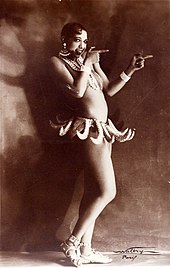
In 1931 Josephine sang and recorded her most famous song. "J'ai deux amours (I Have Two Loves)".
As time passed Josephine Baker would become the most popular American entertainer working in France. According to the "Official Josephine Baker Website". American author Ernest Hemingway would refer to her as:
the most sensational woman anyone ever saw.
Josephine Baker's Motion Pictures and the Opera
At this point I want to look at the motion picture appearances of Josephine Baker, because, of course, this is a motion picture history blog.
Back on September 18, 1924 a silent film was released entitled "A Son of Satan". It was made for all black audiences. We know the film was about a man who takes a bet to spend the night in a haunted house. We know that members of the Broadway cast of "Shuffle Along", specifically the chorus line, appeared in the feature. It is rumored that Josephine Baker was in that chorus line and some websites and other writings mention this. However, this has never been confirmed and we know Josephine didn't start "Chocolate Dandies" until September 18th. So the possibility does exist of her being in this lost motion picture in the chorus line sequences.
In February 1927 a French/German Production, "Die Frauen von Folies Bergere (The Women from the Folies Bergere)" was released.


I could locate the cast and production crew's name, but not what the picture was actually about. We know that Josephine performed some of her dances in this silent feature, but if she had a bigger role that is unknown.
On February 25, 1927 "La folie du jour (The madness of the day)' was released in France and the film was released in Japan on July 4, 1929, but no other releasing information is available. I couldn't find a plot, but it may have been a filmed version of the 1926/1927 "Folies Bergere" show from 1926 into 1927 of that same name. The following are from the film.
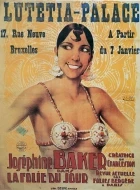
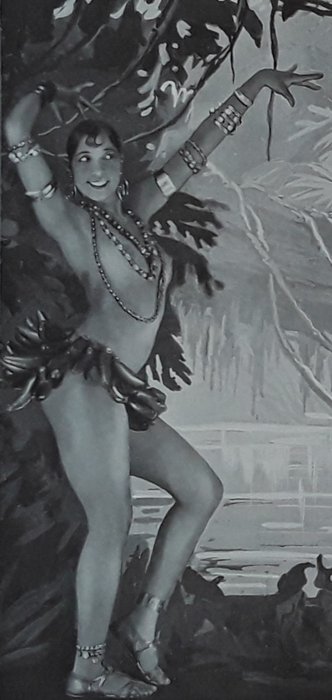
Also in 1927 Josephine Baker's name is listed in the cast of the French film "Le navire aveugle (The Blind Ship)". This motion picture was about a ship's crew that goes blind, but I could find no other information about the film, As to what part Josephine might have portrayed is unknown. The entertainer's name appears last after ten other actors without a character's name beside it. It is even possible that the crew was just looking at a film of her dancing in a sequence.
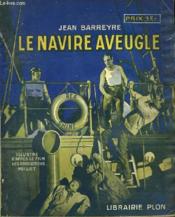
Released December 30, 1927 in Paris was Josephine Baker's first major motion picture. The title was "La sirene des tropiques (Siren of the Tropics)" and Josephine played "Papitou" the title character.
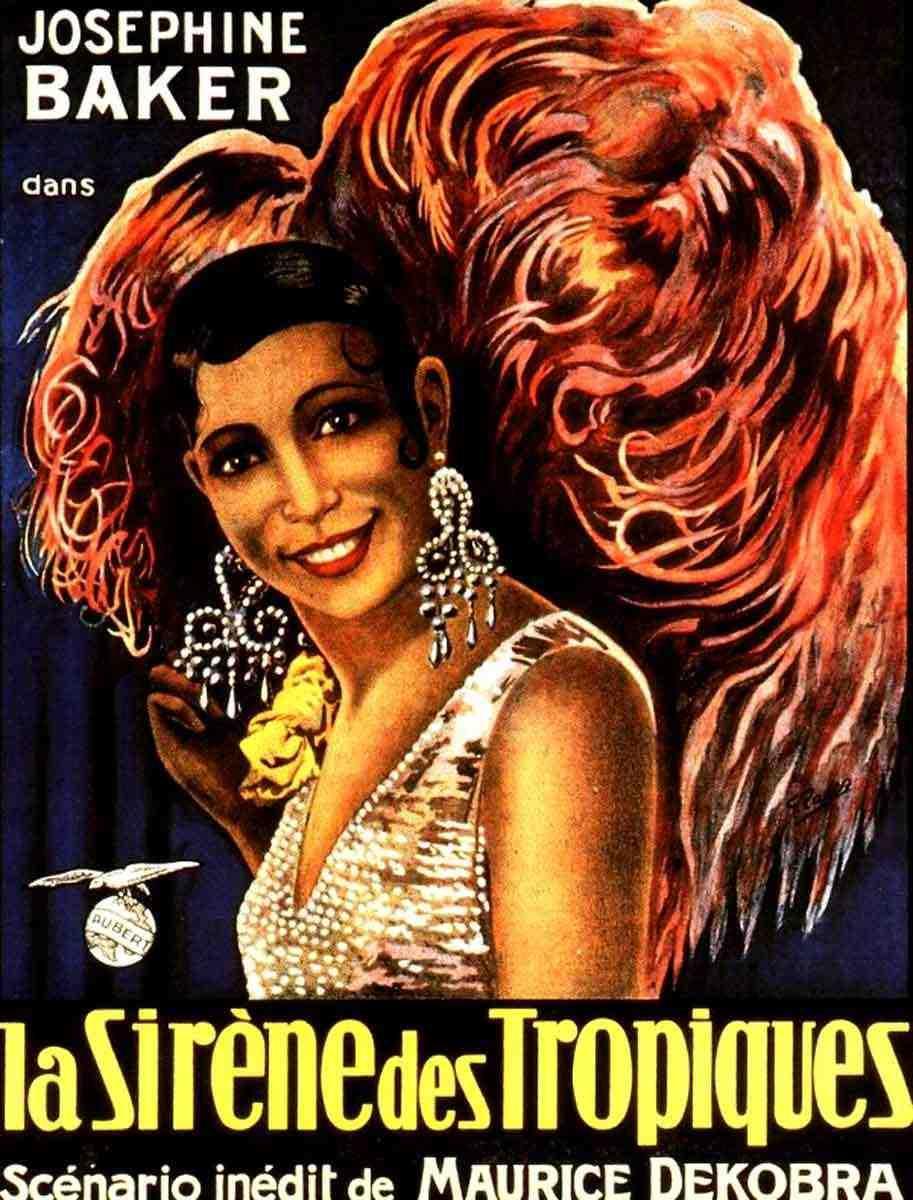
The plot for the picture is described by "Snow Leopard" on IMDb as:
Marquis Sévéro, a rich, lazy Parisian, wants to divorce his wife so that he can marry his own goddaughter Denise. But Denise herself loves André Berval, an engineer employed by the marquis. Filled with jealousy, the marquis sends André to the Antilles, to prospect some land he has just acquired. He promises André that he can marry Denise if he is successful in the tropics, but he then writes to Alvarez, his manager at the site, asking him to prevent André from ever returning to France. The brutal Alvarez forms an instant hatred for André when the engineer breaks up Alvarez's attempt to rape Papitou, a beautiful native girl. Papitou becomes devoted to André, and protects him against Alvarez's schemes. But she faces a crisis herself when she learns that André plans to marry Denise.
.


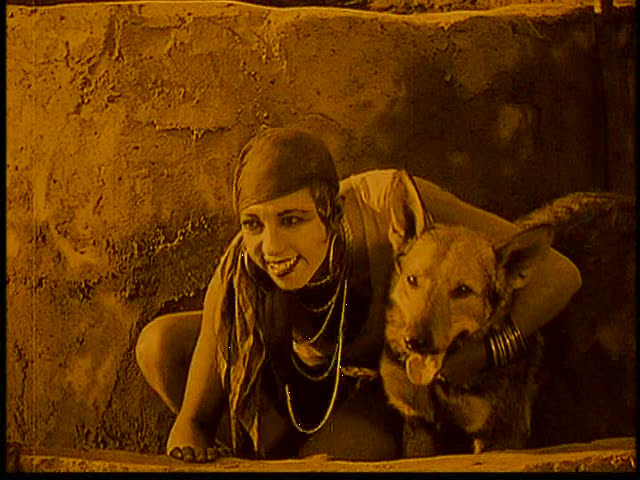
Two events occurred in December 1934 that were important to the career and popularity of Josephine Baker. The first showed the actual managerial skill of her Sicilian lover Abatino. He convinced the entertainer to take extensive voice instruction to improve both her dictation and her singing ability. . Giuseppe Abatino then was able to get Josephine the title tole in a revival of Jacques Offenbach's opera "La creole" at the prestigious "Theatre Marigny" in Paris for a six month run. The street singer from St Louis, Missouri was singing Opera in Paris, France.
According to the website: "Ablackwomen.com", in 2012, Welsh Songstress Dame Shirley Veronica Bassey. Who among other hits belted out the theme songs for the James Bond films "Goldfinger", 1964, "Diamonds Are Forever", 1971, and "Moonraker" in 1979. Considered Josephine Baker her primary influence on her decision to become a singer and entertainer. Describing Josephine performing Opera Shirley Bassey said:
she went from a 'petite danseuse sauvage' with a decent voice to 'la grande diva magnifique'...I swear in all my life I have never seen, and will never see again, such a spectacular singer and performer.
On December 21, 1934 Josephine became the first black women to star in a major motion picture anywhere in the world. The film was "Zouzou".

The film starts at a circus where "Zouzou", Baker, and "Jean", Jean Gabin, were "Paired" as twins. One Dark, One Light. Now he works as an electrician at a music hall and she is the laundress for it. Zouzou is in love with him, but he's in love with her friend "Claire", Yvette Lebon. "Jean" is accused of murder and it is up to "Zouzou" to prove his innocence. While becoming the star of the musical hall's show.
The film was a major European hit, but didn't come to the United States until February 10, 1989 for a special New York City showing.
On November 2, 1935 Josephine was "Princes Tam-Tam", or was she? This is a variation upon George Bernard Shaw's "Pygmalion". A French author, "Max de Mirecourt" played by Albert Prejean, visiting Tunisia meets a young girl, "Alwina", Baker. He will turn her into a lady of culture and passes "Alwina" off as a "Princess Tam-Tam". Unlike Shaw's story both "Alwina" and Max's" lives are adversely affected and at the films ending. Both have returned to the happiness of their own worlds. He as a writer and she as a shepherdess.
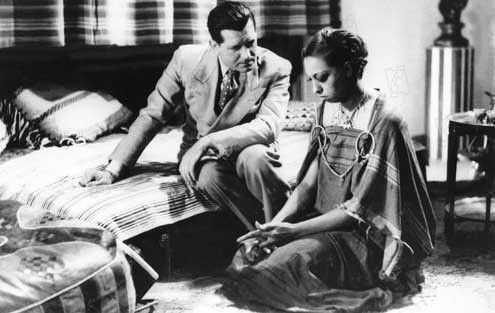
The motion picture was shown in New York City once, but the Hayes Office refused to permit the film to be released anywhere else in the United States. Stating the picture contained objectionable content including nudity. However, "Princess Tam-Tam" was permitted to be shown in its entirely at Independent Negro movie houses. This action toward Josephine Baker's movie was a sign of what awaited the entertainers return to the country of her birth.
It took me some research time to figure out what the listed Josephine Baker 1940 motion picture "Moulin Rogue" was about. What caught my attention was casting her as "Princess Tam-Tam". I discovered that actually there was no such motion picture initially shot with her.
"Moulin Rougue" was a heavily edited version of Josephine's "Princess Tam-Tam" with the entire role of "Max de Mirecourt" being removed. The story, through added footage, had been changed to one about an aspiring nightclub singer, "Lequerec". played by Rene Dary. The actor was not in the original film. Josephine now appears mostly as an act called "Princess Tam-Tam"\ and her dance routines are also heavily edited. The film was first released in Finland in 1940 and did not come to the United States until 1944 for General Release at all movie houses.
The Ziegfeld Follies and Allied Spy
In 1936 Josephine Baker returned to the United States to appear in a revival of the 'Ziegfeld Follies". Note the following poster with Fanny Brice's name at the top "and Josephine Baker" at the bottom. That is a technique still used in motion pictures to bring attention to a certain actor, but it also reflected that Josephine was not a known name in the United States. Even though she was a major star throughout Europe. Also notice the first name on the left after Franny Brice's is a comedian by the name of Bob Hope.


Below the marquee for the show. Josephine Baker's name appears at the bottom of the list of names above the theater's entrance and box office.


America's tastes did not go style of Josephine Baker and the critics went after her performances, but their words betrayed the truth.
According to Alan Schroeder and Heather Lee Wagner in their 2006: "Josephine Baker: Entertainer". The "New York Times" newspaper had a completely different view of Josephine than Shirley Bassey above. The legitimate theater critic called her a:
Negro wench...whose dancing and singing might be topped anywhere outside of Paris.A direct racial attack on the entertainer that the "New York Times" was not worried about putting in writing in their review. A reflection of White America's attitudes toward entertainers of color. Other critics, according to the the two authors, described Josephine Baker's voice as both "too thin" and "dwarf like",
According to the website "All Music":
The act floundered, however, as Baker was subjected to a double dose of discrimination; cultural conservatives railed against the show's promiscuity, while many hotels and restaurants refused entrance to the star of the show. When Brice fell ill, temporarily halting the revue, Baker broke her contract and fled to Paris.
The final insult came after the revue resumed and Josephine Baker was replaced by Louise Hovick an actress who had appeared in two motion pictures in 1937, but appeared in the "Ziegfeld Follies" under her stage name "Gypsy Rose Lee" and performed her strip tease to rave reviews. Not criticizing Miss Hovick here, but the idea of Josephine's act being too promiscuous. While "Gypsy's" wasn't to the same "cultural conservatives" of New York City is hard to swallow. Below "Gypsy Rose Lee" during her "Ziegfeld Follies" engagement.

After Josephine Baker left the United States she made two major changes to her life in 1937. The first was renouncing her United States citizenship over her treatment and becoming a French citizen. The second was her marriage to French industrialist and sugar king Jean Lion.

Race was not a problem for the couple in France, but sometime in 1938 they divorced. Some sources make mention of the fact that Jean Lion was Jewish. They state this put a strain on the couple's relationship after Hitler invaded causing the divorce.
The historical problem is that Hitler did not invade Poland until 1939 and that event started the Second World War. While, France, itself, was not invaded by the Germans until 1940 two years after the divorce. It is possible and I could not confirm, or deny this. That if Jean Lion had dealings in Germany and other European counties pre-1939 pressures might have existed, but that seems highly unlikely.
At the outbreak of the war Josephine Baker was recruited by the "Deuxieme Bureau de l'Etat-major general (Second Bureau of the General Staff)", or simply put "French Military Intelligence". As a recognized International Entertainer Baker was free to travel throughout Europe and report back. She specialized in gatherings and parties held by different embassies and ministries. Josephine met and charmed Japanese, Italian and German diplomats, military officers and business leaders and passed on her information to the "Duexieme" during 1939 and into 1940.
Once Germany actually invaded France. Josephine Baker left Paris for the countryside and a home she was renting. In 1947 Baker would purchase that property known as the "Chateau des Milandes",

Initially Josephine housed people who were helping the 'Free French" under the exiled General Charles de Gaulle and supplied them with counterfeit Visas and other documents. Which helped them to get out of France and to England fighting for a Free France.
With German approval Josephine Baker and her entourage traveled in and out of the country. She visited neutral Portugal and went to South America performing, but all the time gathering vital information for the allies. In 1941 she left for the "Vichy France" controlled countries of North Africa. Remember Humphrey Bogart and Ingrid Bergman in 1942's "Casablanca"?
The "Vichy" French government had signed an armistice with Germany and represented Hitler in both France and all the French controlled colonies. Being recognized by Germany permitted Baker to travel freely in these areas picking up information and passing it on to England from 1941 through 1942.
During the above period Josephine actually pinned notes on the information she was collecting in her underwear. She counted on her celebrity status to avoid being stripped searched as other women were having to endure. While in Morocco the entertainer met with the "Pasha of Marrakesh" Thami El Glaoui known in English as "The Lord of the Atlas".

Below Baker with her cheetah "Chiquita" in Marrakesh.

It was while visiting with the Pasha that Josephine Baker had another miscarriage, but an infection occurred resulting in the entertainer having to have a hysterectomy. After her recovery Josephine knowing that the Free French had no organized entertainment for their troops. Made a decision to use her own money to start touring and entertaining French, British and American troops in North Africa.
As a result of her resistance work and the entertaining of the troops. Josephine Baker was made a sublieutenant in the Free French Air Force.


At the end of World War 2 Josephine Baker was awarded the "Croix de Guerre (the Cross of War)"/ The "Medalle de la Resistance" aka: the "Rosette de Resistance" established by President Charles de Gaulle to honor those who contributed to the resistance against Germany. Additionally Josephine received from de Gaulle the "Ordre national de la Legion d'honneur (National Order of the Legion of Honor aka: Chevalier of the Legion d'honnour)". This is the highest French order of merit for military and civilians. It had been established in 1802.
Another Marriage, A Triumphant Return and Racism Once More
In 1947 Josephine married French composer Jo Bouillon.

Below an album the couple made.
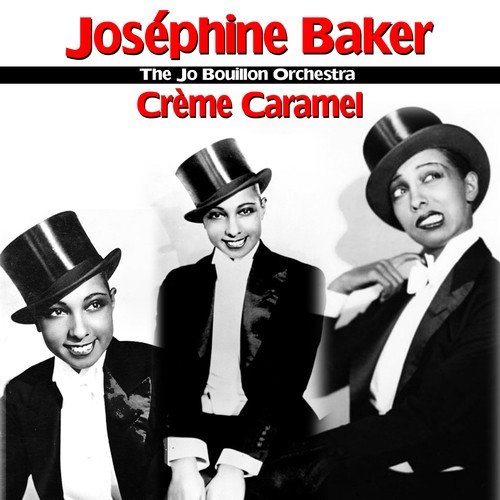
In 1949 Josephine returned to the "Follies Bergere" and as a result of her war time service. The entertainer found she was also able to choose the type and style of music she wanted to perform. She added more serious music such as opera.
1951 was an eventful year for Josephine Baker. It was during it that she started to adopt children from different countries. In the end she would have 12 including Jean Claude and refer to them as "The Rainbow Tribe".
Below Josphine and Jo with eight of her adopted children.

When "The Rainbow Tribe" was complete. Josephine Baker's 12 children were two girls and ten boys. They are:
French born Marianne, Moroccan born Stelina, Korean born Jeannot (or Janot), Japanese born Akio, Colombian born Luis, Finnish born Jan, French born Jean-Claude and Noel, Israeli born Moise, Algerian born Brahim, Ivorian ("Republic of Cote d'Ivorie" on the African Ivory Coast) born Koffi and Venezuelan born Mara.
1951 also saw Josephine Baker returning to the United States. After accepting an invitation to appear at a Miami, Florida nightclub. The first problem she found was the club was segregated. The entertainer started a very public battle over desegregating the club as a condition of her appearing there. It worked and the club was sold out every night of her show. She then decided to follow this up with a National Tour.
There were highs and lows with that tour. In one instance Josephine cancelled an Atlanta, Georgia appearance, because the club would not change its segregation policy. However, her drawing power changed Las Vegas. The city was segregated and all the shows on "The Strip" were White only, but the casino's were out to make money. Josephine Baker was the first entertainer of Color to play in a major Las Vegas Show Room. From her appearance forward the city started desegregating itself.
Los Angeles wasn't a problem for the entertainer as the Hollywood elite turned out. Read the comment on the bottom of the following picture with Jerry Lewis.

Then there was New York City. Upon arriving with her husband. The couple were refused reservations at 36 different hotels, because she was Black. In contrast was her return to Harlem were an estimated 100,000 people lined the streets to welcome Josephine Baker. She had just been named the NAACP's "Women of the Year".
Josephine Baker worked closely with the NAACP over racial discrimination and had developed a reputation as a crusader for Equal Rights. The organization declared Sunday, May 20, 1951 as "Josephine Baker Day".This also had a reverse effect as many Black Public Figures were afraid she might actually cause problems for the movement, because of her notoriety.

It wasn't just finding a room to sleep in that became a New York problem for the entertainer. There was Manhattan's "Stork Club" owed by and wanting diner. Josephine stated she was refused service there, because of her race. The club was owned by ex-bootlegger Sherman Billingsley in 1951.
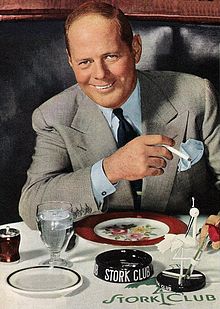
On the evening the incident took place. Actress Grace Kelly was seen storming out of the club with her friends taking Josephine along and stating she would never eat there again, Kelly lied! She returned with her boyfriend Prince Rainier of Monaco in 1956. However, over this incident the two ladies became very close friends.

The above poster contains a quote from columnist Walter Winchell on how great an entertainer Josephine Baker. is, but his point of view changed over the "Stork Club" incident. Winchell and Baker were old friends, but when he would not support her position over the club's segregation policy. She scolded him and he turned against her. Winchell in his next column called Josephine Baker a "Communist Sympathizer". In 1950's America Walter Winchell's power was death to an entertainer, but in Josephine's case it took a little time to materialize.
Josephine filed a lawsuit against Winchell. The details are below in this newspaper article.
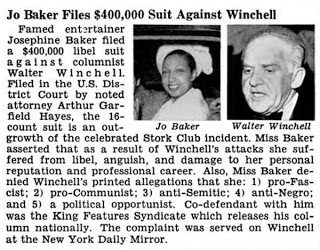
In February 1952 Josephine Baker gave a performance for her home town crowd.
However, sometime after that performance and as a result of Walter Winchell's claims that she had anti-American sympathies. Josephine's "Work Visa" was revoked and she returned to France.
It would be 11 years before Josephine Baker was permitted back into the United States and that return brought her once to the forefront of the Civil Rights Movement. The year was 1963 and two years earlier she had divorced Jo Bouillon.
The exact date was August 28th and the place Washington, D.C.

On that day the Reverend Dr, Martin Luther King, Jr. told the audience that "I Have A Dream".

According to the website "Inforplease,com":
The speakers included all of the "Big Six" civil-rights leaders (James Farmer, who was imprisoned in Louisiana at the time, had his speech read by Floyd McKissick); Catholic, Protestant, and Jewish religious leaders; and labor leader Walter Ruether. The one female speaker was Josephine Baker, who introduced several "Negro Women Fighters for Freedom," including Rosa Parks.https://www.infoplease.com/civil-rights-march-washington
Josephine wore his French Air Force Uniform with all of her medals that day.

Below Josephine with Lena Horne at the march.

On April 4, 1968 in Memphis, Tennessee the Reverend Dr. Martin Luther King, Jr was assassinated. According to her autobiography "Josephine" first published posthumously in 1977. Coretta Scott King met Josephine Baker while she was touring in the Netherlands. Again, according to the entertainer, she was asked to take over the leadership of the Civil Rights movement by Mrs. King. After several days of deliberations Josephine declined, because her children came first.
That same year Josephine declared bankruptcy and lost her home. Now Princess Grace of Monaco, her friend Grace Kelly, offered an apartment in Roquebrune-Cap-Martin near Monaco to the entertainer and her children.
Shortly before her death Josephine Baker performed in a retrospective review celebrating her 50 years is show business. It was financed by Prince Rainer, Princess Grace and Jackie Kennedy Onassis. The April 8, 1975 opening night audience included Mick Jagger, Sophia Loren, Shirley Bassey, Diana Ross and Liza Minnelli.
Four days later on April 12, 1975 surrounded by newspaper reviews of her performance on her bed. Josephine Baker suffered a cerebral hemorrhage and passed away.
"Place Josephine Baker" is in the Montparnasse Quarter of Paris.
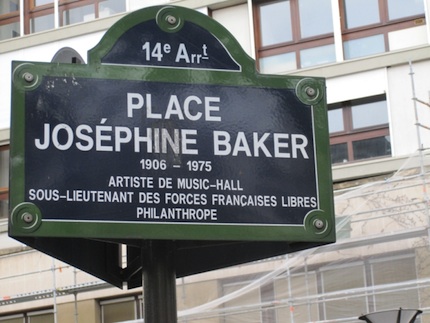
My reader will also find her name on the "St, Louis Walk of Fame" and in "The Hall of Famous Missourians".
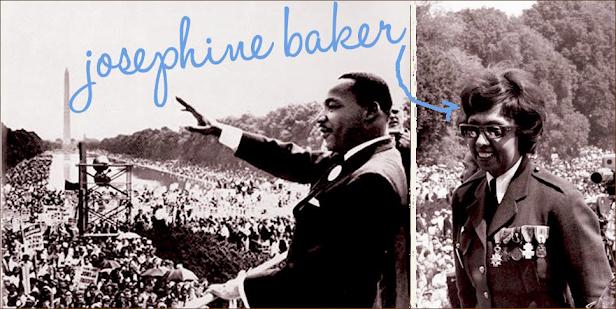



No comments:
Post a Comment